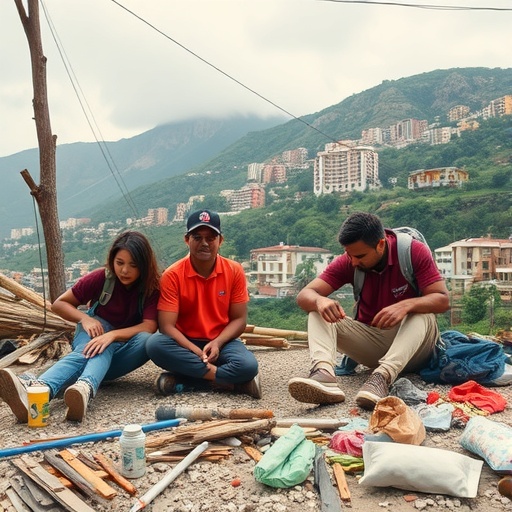In the wake of devastating earthquakes, the ripple effects extend far beyond the initial destruction, profoundly influencing mental health and social dynamics among affected populations. A groundbreaking new study published in BMC Psychiatry delves into the intricate psychological and social adaptations experienced by university students residing alongside earthquake survivor families in state dormitories. This research sheds light on an underexplored facet of disaster aftermath—the sustained mental health impacts on those indirectly affected through close cohabitation with survivors.
Conducted between May and August 2023, the study employed quantitative cross-sectional methods to scrutinize the adaptation processes and anxiety levels among 108 university students placed in state-run dormitories. These dormitories housed families who had directly endured seismic catastrophes, allowing for an unprecedented examination of how shared living spaces influence mental well-being. Data collection leveraged standardized tools including a Descriptive Characteristics Form and the widely recognized Beck Anxiety Scale, analyzed rigorously using SPSS 25.0 software.
One of the compelling revelations from this research is that nearly half of the student participants reported increased contact with their own families post-earthquake. This suggests that the traumatic event extended the domain of social interaction and heightened familial engagement, potentially as a coping mechanism or a search for emotional solidarity. However, while this increased contact could afford positive social support, it coexisted with notable psychological strain within the dormitory environment shared with disaster survivors.
The findings reveal a dichotomous experience tied to cohabitation with earthquake-affected families. More than half of the students indicated that sharing limited personal space in the dormitories had significant emotional consequences. Approximately 56% felt compelled to sacrifice privacy, while 51% experienced emotional disturbances. Conversely, a similar proportion derived emotional support from their proximity to these families, indicating complex, nuanced psychological interactions influenced by coexistence in post-disaster settings.
Moreover, the study highlights a measurable shift in students’ social behaviors and perspectives post-earthquake. Nearly half of the participants acknowledged changes in their attitudes and social lives, signaling that the disaster’s ramifications transcended immediate trauma, prompting a reevaluation of social norms and self-understanding. Notably, over half reported increased awareness and sense of social responsibility, suggesting that proximity to disaster survivors fostered a collective consciousness and heightened community empathy.
Perhaps most strikingly, regression analyses revealed that living in the same environment as earthquake survivor families accounted for approximately 33.7% of the variance in anxiety levels measured by the Beck Anxiety Scale. This statistically significant relationship underscores that the psychological burden borne by these students was not incidental but closely tied to the stressors inherent in their living circumstances.
The data explained that for each incremental unit increase in the intensity of cohabitation with earthquake-affected families, there was a corresponding 5.379-point increase in anxiety scores, underlining a causal link between environmental and social stressors and elevated anxiety. This quantification provides evidence that the psychological toll is substantial and demands active intervention.
These insights carry profound implications for disaster response policy and university welfare programs. The mental health challenges faced by students living alongside trauma survivors call for tailored psychological support services designed to mitigate anxiety and foster healthy adaptation. Such interventions are critical not only to support individual well-being but also to strengthen the broader social fabric in post-disaster recovery phases.
Integrating psychological aid into state dormitories could take several forms, including counseling, peer support networks, and resilience training, all designed to empower students to navigate the emotional complexities of their unique living environment. Addressing these needs proactively may prevent the escalation of mental health conditions and promote sustained psychosocial recovery.
The study’s authors emphasize that the close proximity to disaster survivors creates an environment rich in both support and stress, underscoring the need for nuanced approaches that recognize this duality. Understanding this dynamic can guide future housing policies and mental health strategies in disaster-affected regions, ensuring vulnerable populations receive comprehensive care.
Furthermore, this study paves the way for expanded research into the psychosocial dimensions of indirect disaster exposure, particularly among young adults in institutional settings. By illuminating the multifaceted nature of adaptation and anxiety, it encourages a holistic perspective in both academic inquiry and practical disaster management.
As earthquakes and other natural disasters continue to affect vast populations worldwide, the mental health repercussions extend into unseen quarters. The university students living with earthquake survivor families exemplify a demographic caught between direct trauma and secondary exposure, revealing the pervasive reach of such calamities.
This research not only contributes valuable data to the field of psychiatry but also fosters broader societal awareness of the layered consequences of disasters. By highlighting the psychological vulnerabilities of cohabitating students, it invites policymakers, educators, and mental health professionals to rethink support frameworks for affected communities.
Ultimately, the findings stress the indispensability of integrating mental health resources in post-disaster environments, particularly in shared living situations, to ensure comprehensive recovery and promote resilience among young individuals navigating complex emotional landscapes.
Subject of Research: Adaptation processes and anxiety levels of university students residing with earthquake survivor families in state dormitories
Article Title: Analysis of adaptation processes and anxiety levels of university students staying with earthquake survivor families in state dormitories
Article References:
Dağ, İ., Olğaç, K. Analysis of adaptation processes and anxiety levels of university students staying with earthquake survivor families in state dormitories. BMC Psychiatry 25, 792 (2025). https://doi.org/10.1186/s12888-025-07265-6
Image Credits: AI Generated




